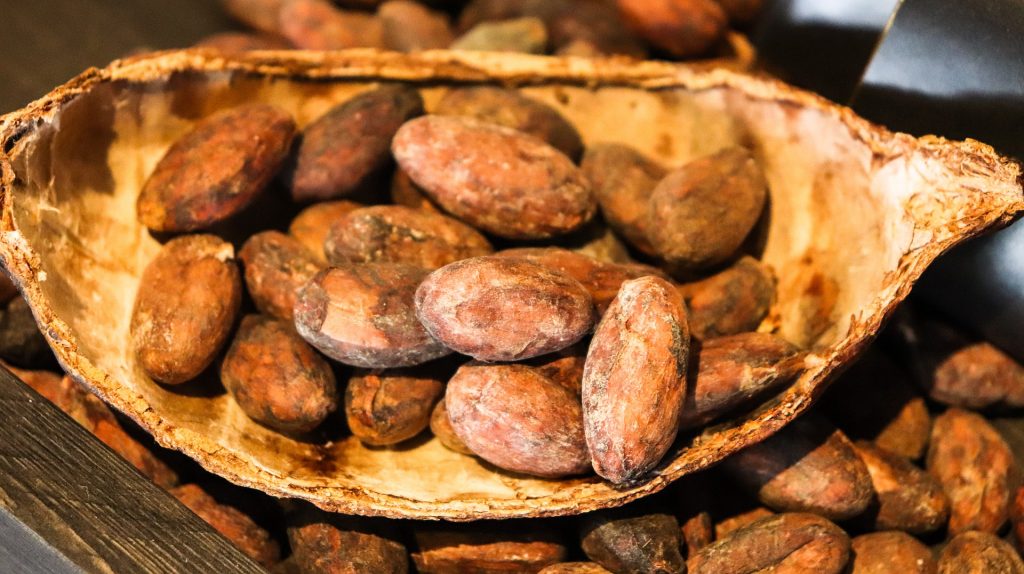I have been eating chocolate daily for years. I crave chocolate. I love chocolate.
I am not alone. About 7.3 million tons of retail chocolate confectionery were consumed globally in 2015/2016! (1)
My family holiday tradition is the gifting of See’s chocolates, but as I attempt to decrease my sugar intake, I have made a commitment to eat less chocolate.
What is it about chocolate that we fall in love with?
Chocolate is made from tropical Theobroma cacao tree seeds. Its earliest use dates back to the Olmec civilization in Mesoamerica. The word cacao originated from the Mayan word, “Ka’Kau.” Ancient Aztecs considered Cacao the “Food of the Gods.” Cacao was a pillar of the Mayan, Aztec, and Nahua communities, economies, and religions as a sacred medicine.
In Mayan and Aztecan culture, cacao is a sacred crop and has historically been used for ceremonial practices, known as “Cacao Ceremony” or as offerings to the Gods.
Cacao & Cocoa

Cacao and cocoa are both milled and processed from the cocoa bean, but cacao is processed at a low temperature and considered raw. Cacao contains antioxidants, vitamins, minerals, and protein.
Cocoa is the term used to refer to the heated form of cacao. Cocoa undergoes a higher temperature during the processing and some of the nutrients are lost, although it still retains antioxidants.
Cacao is stronger flavored than cocoa. Dutch-process cocoa is cocoa that has been treated with an alkalizing agent to modify its color and give it a milder taste. Dutch cocoa forms the basis for much of modern chocolate.
In the 1980s phenylethylamine (PEA) was discovered in chocolate. PEA acts as a CNS stimulant and increases the brain’s production of norepinephrine and dopamine-producing the euphoric effect often associated with a “runner’s high.” Cacao also helps to boost anandamide, a fatty acid neurotransmitter, which is also known as the “bliss molecule.” And cacao contains theobromine which has an effect like that of caffeine in the nervous system.
No wonder why so many of us love chocolate!
Recently, there have been studies that found that cocoa flavonoids including epicatechin have an anti-diabetic effect by enhancing insulin secretion, improving insulin sensitivity in peripheral tissues, exerting a lipid-lowering effect, and preventing the inflammatory and oxidative damages of the disease. (2)(3)(4)
Chocolate is often heavily sweetened as in See’s candy, but there are many chocolate bars that contain more cacao or cocoa and less sugar. Lately, I have purchased cacao powder and have been making a hot drink with coconut milk, monk sugar, and spices.
New Tradition & Recipies
My daughter and I are going to start a new tradition this holiday season. We are not going to gift See’s candy, but instead, we are going to gift cacao.
1 TB Cacao powder has
- 3.2 gms of carb
- 0 gms of sugar
- 1.6 gms of protein
- 2 gms of fiber
- 0.6 gms of fat
- 0.8 mg of iron
- 14 mg of calcium
- 42.4 mg of magnesium
- 120 mg potassium
- 19.6 mg theobromine

Sugar Free Mexican Drinking Chocolate
- 1 13. 5 oz can of full fat coconut milk
- 1 cup water
- ¼ cup cacao powder
- 4 Tb granulated monk fruit sweetener
- ½ tsp vanilla extract
- 1 tsp ground cinnamon
- 1 dash cayenne
- 1 dash Celtic sea salt
Combine is a small saucepan and whisk until the consistency is smooth and silky. Pour into mugs. Give thanks. Enjoy.
References:
- Consumption of retail chocolate confectionery worldwide 2012/13-2018/2019. Statistic Research Department, Nov 2, 2015
- Antioxidants (Basel). 2017 Dec;6(4):84, Published online 2017 Oct 31. Doi: 10:3390/antiox6040084
- Marin M. A., Fernandez-Millan F., Ramos S., Bravo L., Goya I., Cocoa flavonoid epicatechin protects pancreatic bet cell viability and function against oxidative stress. Mol. Nutr. Food Res. 2013;58:447-456
- Katz DL, Doughty K, Ali A. Cocoa and chocolate in human health and disease. Antioxid Redox Signal. 2011;15(10):2779-2811










